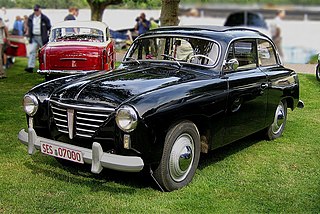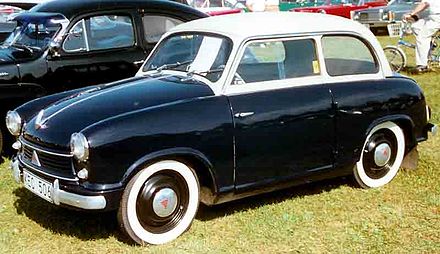
The former Borgward car manufacturing company, based in Bremen, Germany, was founded by Carl F. W. Borgward (1890–1963). It produced cars of four brands, which were sold to a diversified international customer base: Borgward, Hansa, Goliath and Lloyd. Borgward's Isabella was one of the most popular German premium models in the 1950s, while Lloyd's Alexander / Lloyd 600 model offered affordable mobility to many working-class motorists. The group ceased operations in 1961, following controversial insolvency proceedings.

The BMW New Class was a line of sedans and coupes produced by German automaker BMW between 1962 and 1977. These models ensured BMW's solvency after the company's financial crisis of the 1950s and established the identity of BMW automobiles as sports sedans.

Carl Friedrich Wilhelm Borgward was a German engineer and designer and the creator of the Borgward group, based in Bremen.
Goliath-Werke Borgward & Co. was a German car manufacturer started by Carl F. W. Borgward and Wilhelm Tecklenborg in 1928, and was part of the Borgward group. Goliath was based in Bremen and specialized in three-wheeler cars and trucks and medium-sized cars. Their vehicles were sold under the Goliath brand.
Hansa-Automobil Gesellschaft m.b.H was a German car brand established in 1905, which in 1914 was merged with Norddeutsche Automobil und Motoren AG (NAMAG) into Hansa-Lloyd-Werke A.G.. From 1929 to 1931 it was taken over by the Borgward group. Hansa was based in the Bremen suburb of Hastedt.

The Borgward Isabella is an automobile which was manufactured by the Bremen based auto-manufacturer Carl F. W. Borgward GmbH from 1954 to 1962.

The Goliath GP700 is a small automobile which was manufactured by the Bremen, Germany–based Borgward subsidiary Goliath-Werke Borgward & Co from 1950 to 1957. In 1955, the GP700 was joined by the larger-engined Goliath GP900 E. From 1951 to 1953, a coupé version, the Goliath GP700 Sport was offered. The Goliath was a revolutionary design, which in several important respects pointed the way for automobile development in the second half of the 20th century.

The Goliath 1100 and later the Hansa 1100 is a small automobile that was manufactured from 1957 to 1961 by the Bremen based Goliath-Werke Borgward & Co, a subsidiary of Borgward. A two-door saloon and a three-door kombi (estate) version were available from launch and a two-door coupe was introduced a year later. For 1959, the Goliath name was discontinued and the car was rebadged as the Hansa 1100, recalling Borgward’s prewar model of the same name.

The Lloyd LT 500 was a compact van produced and sold by the German automaker Borgward Groups's Lloyd Motoren Werke GmbH in Bremen, Germany between 1953 and 1957. A six seater minivan version was offered by April 1954.

The Lloyd LP 250 is a small car introduced in June 1956 and offered for sale until 1957 by Lloyd Motoren Werke G.m.b.H. of Bremen. The body and running gear came from the existing Lloyd LP 400. The LP 250 differed in having the size of its two cylinder two stroke engine reduced to 250 cc. This produced a claimed maximum power of just 8 kW at 5000 rpm, less, even, than the 9.8 kW of the LP 400.

The Glas 1700 is a middle class four door saloon produced by Hans Glas GmbH at Dingolfing. The prototype was first presented in September 1963 at the Frankfurt Motor Show. Later versions of the coupé and cabriolet bodied Glas GT were also powered, in some cases, by the same engine as the saloon. The saloon was produced between August 1964 and December 1967, but the manufacturer never had the investment capital sufficiently to expand production capability and the model was discontinued after the by now badly indebted manufacturer was acquired by BMW.

The Goliath Pionier is a small three wheeled two seater vehicle first presented by Carl F. W. Borgward at the 1931 Berlin motor show. It remained in production until 1934, by when approximately 4,000 had been produced.

The Borgward B 3000 was a medium-sized truck made by German manufacturer Carl F. W. Borgward GmbH between 1941 and 1944 in the Bremen-Sebaldsbrück works. After World War II, B 3000 production continued from July 1948 to 1950. Also an electric driven version Borgward BE3000 was avail.

The Lloyd 600 was a small car produced by the Borgward Groups's Lloyd Motoren Werke GmbH in Bremen between 1955 and 1961.

The Lloyd Arabella was a passenger car produced by the Borgward Group in West Germany between 1959 and 1961. After the company's controversial bankruptcy the Arabella continued to be produced, albeit in greatly reduced quantities and branded as the Borgward Arabella until 1963. By the standards of the time and place it would have been defined as a small family car.

The Lloyd 400 was a small car produced by the Borgward Group's Lloyd Motoren Werke GmbH in Bremen between 1953 and 1957.

The Lloyd 300 was a small car produced by the Borgward Group's Lloyd Motoren Werke GmbH in Bremen between 1950 and 1952.
The Hansa 400 is a microcar made in 1933 to 1934 by Hansa Lloyd and Goliath Company, Borgward & Tecklenborg in Bremen, Germany. After about a year in production, it was replaced by the next model Hansa 500 with a bigger engine.
The Blitzkarren was a cab-less tricycle freight cart based on a motorcycle. It was produced in 1924 as the first complete production vehicle manufactured by the Bremer Kühlerfabrik Borgward & Co. GmbH. The company, located in Sebaldsbrück, a settlement in Hemelingen, Bremen, Germany previously produced radiators and fenders for Hansa-Lloyd. Between 1929 and 1931 Hansa-Lloyd was acquired by Carl Borgward and his co-investor Wilhelm Tecklenborg. Borgward also renamed his radiator manufacturing company to Goliath-Werke Borgward & Co. GmbH.

Peter Kurze is a German publisher and author. He became known through his book series on the history of the automobile.
























